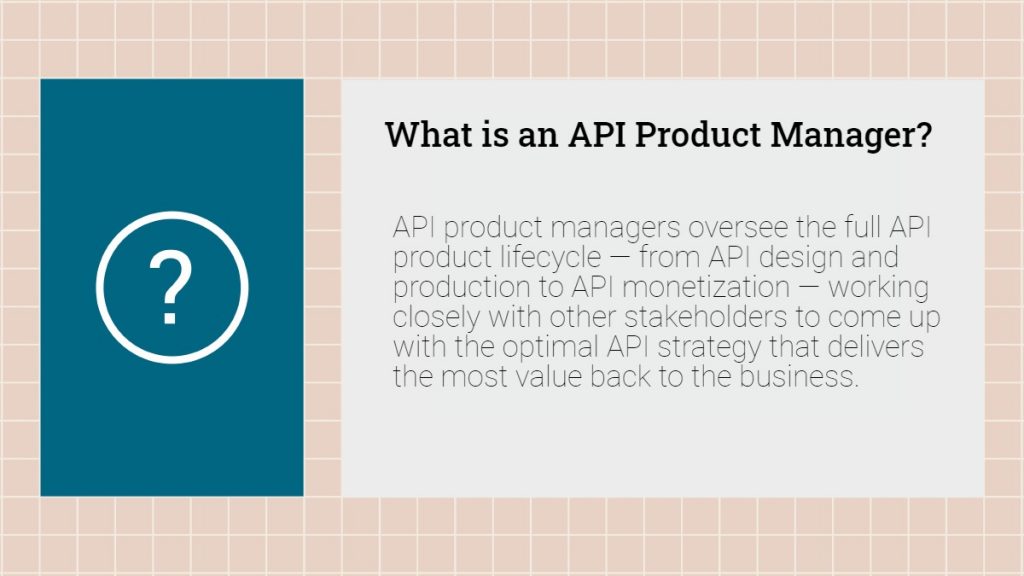We often talk about the need to treat APIs as products, and in the driver’s seat of these efforts is an API product manager. API product managers oversee the full API product lifecycle — from API design and production to API monetization — working closely with other stakeholders to come up with the optimal API strategy that delivers the most value back to the business.
Marty Cagan said it well in his book Inspired: an API product manager should “discover a product that is valuable, usable, and feasible.”
What this entails has evolved over the years, with a push toward API-first organizations and comprehensive digital service marketplaces, and so in turn have the responsibilities and expectations of API product managers.
The rise of the API-first organization
For some time, businesses have looked at APIs through the lens of technical capabilities. The idea has been that APIs function as integration patterns or a means to modernize the IT estate. An API-first approach essentially flips this script and looks at APIs through business capabilities.
In the words of Brian Otten, VP of Digital Catalysts at Axway, “an API-first culture is one in which business and IT teams collaborate to reimagine business capabilities as sets of working APIs first, before rushing to build digital products and services.”
Today, the design and development of every API is connected to the larger business ecosystem. On one hand, API product managers need to be able to easily discover APIs before development begins so they can make use of existing capabilities and minimize redundancies that could result in unnecessary development costs and maintenance. What’s more, API product managers must also standardize the governance of APIs to create consistency across the board for performance, security, and consumption.

In a 2022 analysis of more than 16.7 billion API transactions, researchers at Cequence Security found that 31% of the malicious requests were pointed at unknown, unmanaged, or unprotected APIs. Visibility into the organization’s API inventory sheds a light on these shadow APIs that represent vulnerable points, while the establishment of practices and policies for deployment offers a productization process that prioritizes API security and enhances their long-term value and use.
The need for a marketplace that drives monetization
APIs can be built for quality performance and backed by a universal API management system that creates a seamless experience for users. But if these digital assets aren’t easy to consume, what’s it all worth?
In a 2022 Axway API Adoption survey, 71% of the 300+ IT and business decision makers surveyed reported that they failed to achieve the planned business results from their APIs — often because of a lack of API adoption. Seeing the estimated digital business growth that’s on the line, API product managers need to move beyond the idea of an API portal built for internal purposes and create a “shopping” platform that accommodates external adoption.
That’s where API marketplaces come into the picture. Otten describes an API marketplace as a key platform component for an API program that “acts as the front door for API product discovery while driving the self-service and innovation agenda.”
When built for both technical and business audiences, API marketplaces provide a powerful way for API product managers to easily discover and leverage products for internal use and effectively publicize these digital assets to an external audience (other API product managers included) to drive monetization.
Watch below as Brian Otten, VP of Digital Catalysts at Axway, discusses the role of an API Product Manager:
Meeting modern needs and planning for the future
When you think about the entire API lifecycle, it’s easy to see how API product managers wear many hats: a tech-savvy strategist, researcher, tester, marketer, and customer service representative, to name a few examples. As API use grows and new vulnerabilities and opportunities emerge, the need for API product managers to excel within each of these areas only continues to grow.
As Otten puts it: “API product managers are essentially the bridge between API producers and API consumers. Through collaborative efforts and product intelligence, these individuals help link APIs to business objectives and revenue opportunities these efforts drive.”
As this definition suggests, the ultimate goal of API product managers is to strategically address key business drivers and create an optimal API consumer experience that drives adoption.
Explore the four essential components of an enterprise-wide API strategy.

Follow us on social